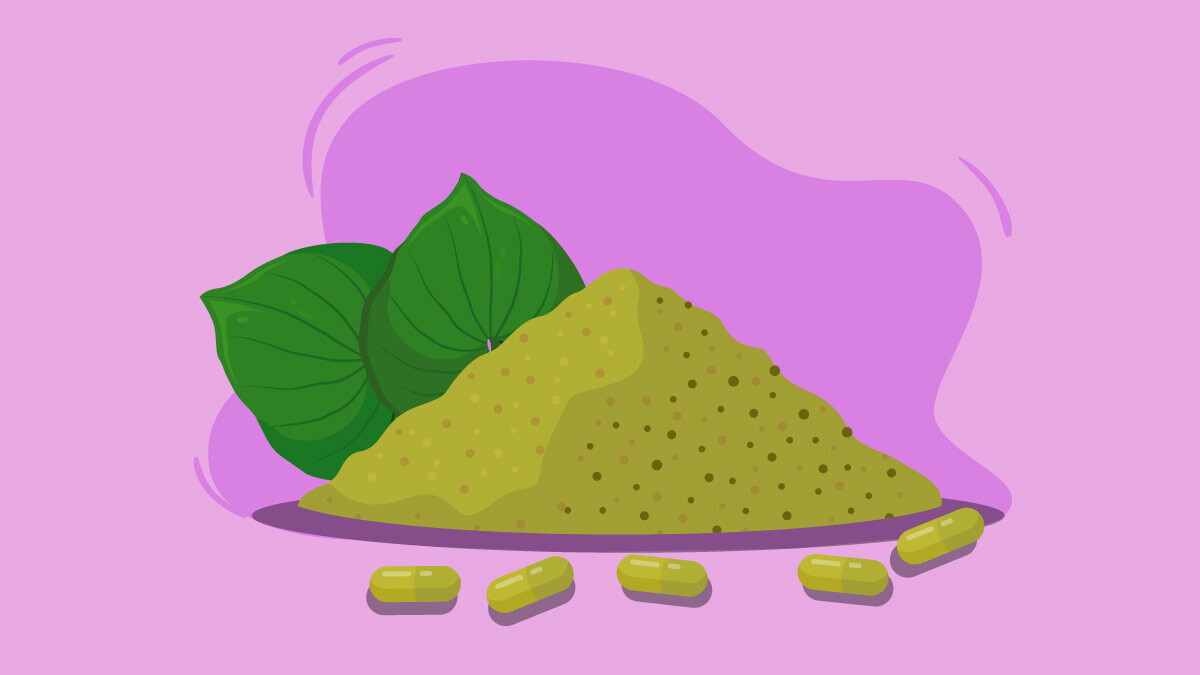Kava has been used as a social lubricant and alcohol alternative for centuries.
There are many different kinds of kava root powder.
Some are more relaxing and better for anxiety — others are powerful sedatives useful for helping you get a deeper, more restorative sleep.
There are even kava root powders that fall in the middle of the spectrum — useful for managing stress and anxiety without making you feel tired.
I’ve tried just about every type of kava I can get my hands on — here are the best kava root powders I’ve found so far.
Best Kava Root Powders (2024 Review)
-
- Gold Bee Micronized Kava Powder — Best Instant Kava Powder Overall
- Root of Happiness Superior Fijian Kava Powder
- Kavafied Kava TONGA
- Kalm With Kava Samoa Ava Kava
- Root of Happiness Fresh Frozen Hawaiian Kava
1. Gold Bee — Micronized Kava Root Powder (Fiji)
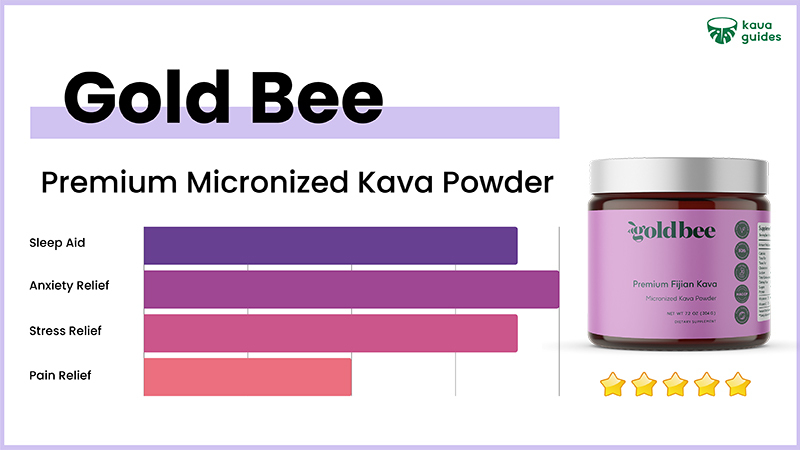
Gold Bee specializes in high-grade, small-batch plant extracts. They carry both kava products and hemp extracts in their lineup.
Everything this company does is done with a high level of sophistication and attention to detail. The same can be said for this micronized kava root powder.
Gold Bee spent several years seeking out the best source of kava they could find. The goal was to find a consistent source of high-grade, premium kava. There are no middlemen taking a cut, and the shipping costs and carbon demand are reduced by opting for micronized kava instead of bulk powder. The cost-to-potency ratio of this powder is unmatched.
The company also opts for carbon-neutral farming practices which consist of manual planting and harvesting, sun-drying, and solar energy harvesting to run an electric micronizer.
This kava has a balanced profile with a rapid onset of effects. If your goal is to get the euphoric and creativity-enhancing benefits of kava, aim for a lower dose (1–2 teaspoons).
If you’re looking for sedating and muscle-relaxant effects, use a higher dose instead (2–4 teaspoons).
2. Root of Happiness — Superior Fijian Kava Powder
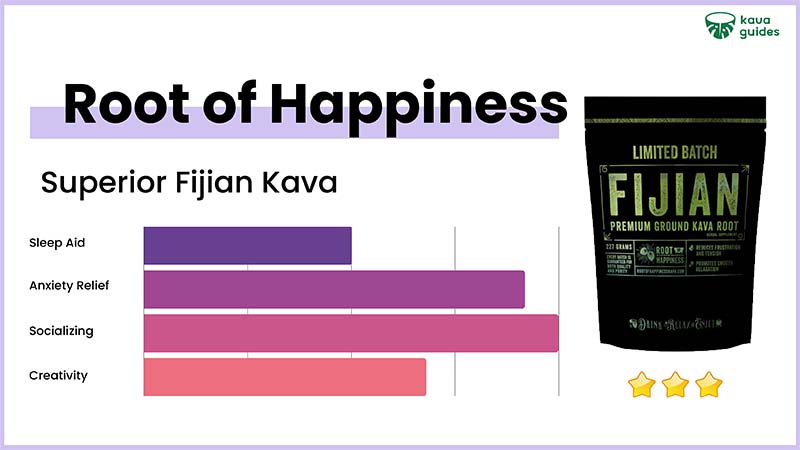
This kava is within the upper-echelon of Fijian kava. It’s harvested from plants that are no younger than 11 years old, grown in the nutrient-rich volcanic soils of Fiji.
The older the kava, the stronger the root.
This 11-year Fijian kava powder from Root of Happiness is also the only certified organic kava root I’ve ever found. This means there were no toxic pesticides or synthetic fertilizers used during cultivation — both of which negatively affect the quality and taste of the plant.
In terms of the effect profile, you can expect from this root — this is heady kava, with average strength. This makes it a perfect choice for drinking with friends, or in the late afternoon to help get the creative juices flowing.
3. Kavafied — Kava TONGA
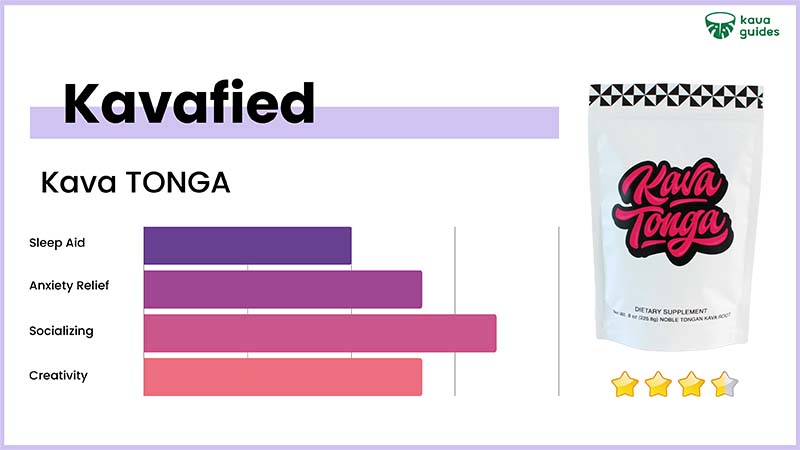
The founder of Kavafied has roots in Tonga — a region known for its excellent kava roots but rarely shares them with the rest of the world.
Tonga is a small place, and there isn’t a lot of land available to grow kava. This means that most of the kava grown in Tonga is used in Tonga.
Through the founder’s connections, Kavafied is able to secure a harvest for themselves, which they share with the rest of the world through their website.
This kava is something special and a must-try for anybody who hasn’t tried Tongan kava yet.
The effects are heady and very strong. This is probably the best kava you’ll find for anxiety due to the sheer strength of the root’s effects.
4. Kalm With Kava — Samoa Ava Kava
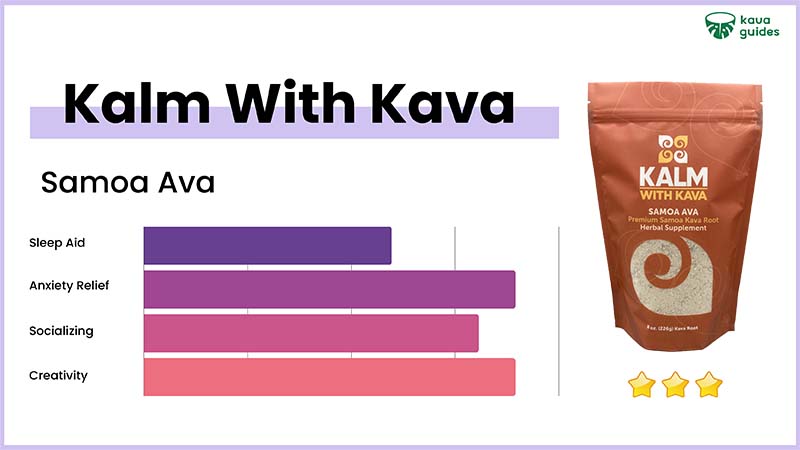
Samoa is another pacific island with some top-notch kava products that aren’t often available to the international public. My family roots are in Samoa, so I may be a little biased on that.
With that said, this root is something special. It’s one of the most well-rounded kavas you’ll find.
What do I mean by that?
This kava is considered balanced in its effects — however, if you take higher doses, it takes a much headier lean.
You can use this kava as a social lubricant with friends, take it at work to inspire new creativity, or take it in the evenings to help with sleep.
This Samoa Ava Kava root by Kalm with Kava is also great kava for beginners because while it’s not too strong, it’s potent enough that you don’t need to drink ten shells just to feel any effects.
5. Root of Happiness — Fresh Frozen Hawaiian Kava
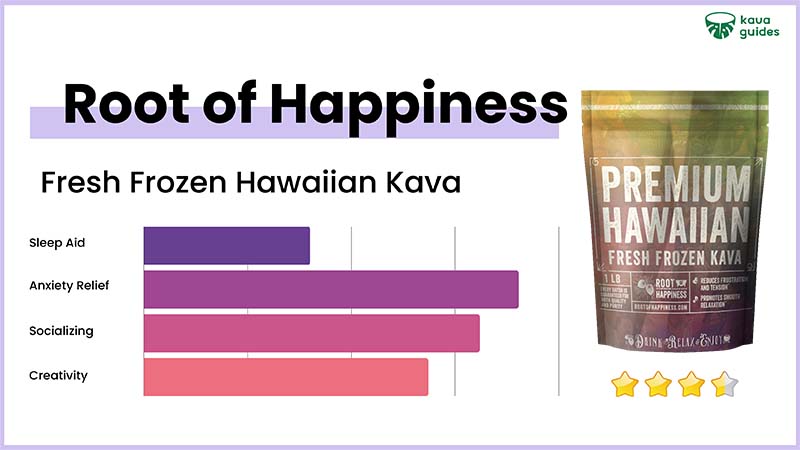
This is a unique offering from Root of Happiness because instead of using dried, powdered root, this product is stored fresh (no drying or processing).
To preserve the kava, Root of Happiness freeze-dries the fresh plants and stores them in a vacuum-sealed bag.
This process preserves the fresh flavor of the kava roots, which are normally lost during the drying process. It also maintains a lot of the natural potency of the fresh kava root.
Root of Happiness has a solid operation going in Hawaii that allows them to provide a steady supply of fresh kava root. These products don’t have nearly as long a shelf-life as dried kava, so the company needs to be consistently harvesting new kava every few months.
Depending on the time of year, there are five different strains to choose from:
- Hanakapi’ai — Balanced kava best suited for social drinking
- Hiwa — Heady kava best suited for anxiety
- Mahakea — Balanced kava best suited for relaxation and social drinking
- Mo’oula — Balanced kava with subtle effect profile
- Nene — Heady kava with an average potency of effects
6. Kalm With Kava — Farm Fresh Loa Waka Kava

This is one of the strongest kavas on the list. Its roots provide an average of 12% kavalactones by weight.
The effect profile of loa waka is considered balanced. In lower doses, it has much more of a heady effect profile. Larger doses produce a much more heavy effect.
I like this kava for watching movies. It’s great to drink with friends because of the social aspect brought on by the heady effects, but the heavier action is perfectly suited for laying comfortably on the couch, a bed, or even just on the floor to take in a movie.
7. The Kava Society — Pacific Elixir Traditional Kava
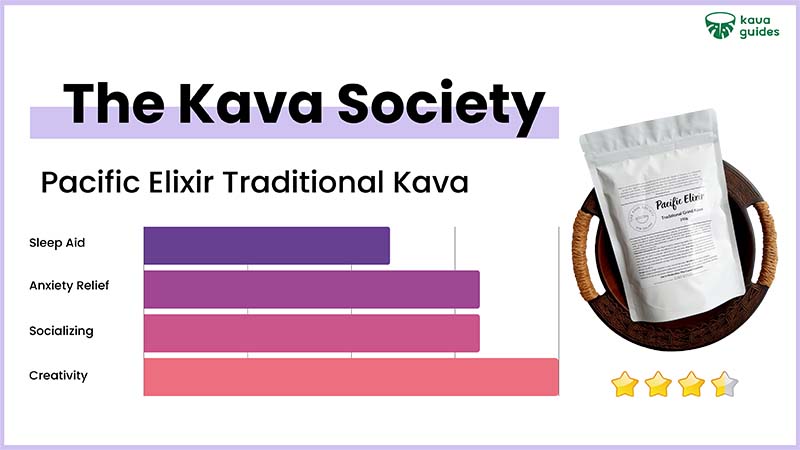
The Kava Society is a New Zealand-based brand curating kava products from all around the pacific ocean. This is the best source of kava if you live in Australia, New Zealand, or New Caledonia.
I like the Pacific Elixir blend because it combines different kava cultivars together for a well-balanced effect. This blend is made from kava sourced from Vanuatu, Samoa, Fiji, Tonga, and Hawaii.
The effects of this kava can vary from one batch to another, but the team over at Kava Society does a pretty great job at stabilizing the blend to keep it consistently in the middle of the heady and heavy spectrum of effects.
This kava is considered average to strong in terms of its potency and is versatile in its uses. I like this one for drinking while I write, or while doing anything creative. It’s also a good option to share with friends.
8. Root of Happiness — Papua New Guinea Kava Powder

As I was putting together this list, I noticed all my top choices were either heady or balanced kavas. I didn’t include any heavy options for people who like the body high associated with kava.
So here’s what I consider the ultimate heavy kava root powder.
This root is technically an ISA cultivar, which many people try to avoid. However, the Madang short cultivar used in this kava is the exception. It’s very strong — don’t be mistaken — but it’s not nearly as likely to cause the negative side effects associated with other ISA strains (mainly nausea and lethargy).
Ths Papua New Guinea Kava Powder is by far the strongest heavy kava I’ve tried.
I primarily like this kava when I’m alone. It’s not the most conducive option for socializing but is a better option for problems with sleep, meditation, or muscle pain.
9. The Kava Roots — Tonga Choice
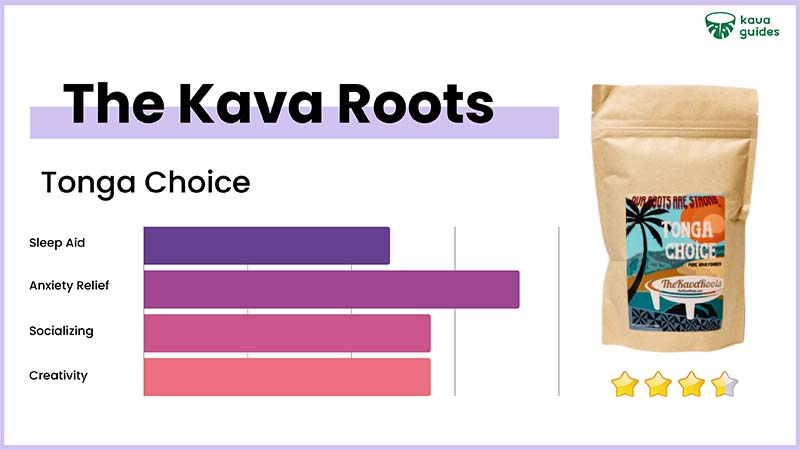
I’m currently living in Canada, which makes it difficult to find kava at reasonable prices. Most of the kava companies in operation today are based out of the United States or New Zealand. Getting kava delivered to Canada is slow, and usually adds about 20% to the total cost.
The Kava Roots is based out of Bowen Island BC — just off the coast of Vancouver.
This is the best source of kava if you’re living in Canada, but Americans can still order roots from this website too.
My favorite option is the Tonga Choice kava. It’s much milder than other kavas on this list, making it a great option for newbies.
If you want something a little stronger, check out the Vanuatu Noble Warrior instead.
What is Kava?

Kava (Piper methysticum) is a tropical plant native to tropical islands like Vanuatu, Tonga, the Solomon Islands, Fiji, Hawaii, and others.
What makes this plant interesting is that it’s completely dependant on humans to survive. This kava plant doesn’t produce any viable seeds, so the roots need to be manually cut and planted to produce new plants.
There’s been an intimate connection between kava and humans for centuries. Early Polynesian colonizers took kava roots with them as they set off in search of new islands. When they arrived, one of the first things they would do is get their kava plantation going.
In exchange for spreading its growing range, kava offered its human companions a source of intoxication and social lubrication. People living on these islands continue to gather each evening to laugh, socialize, and enjoy each other’s company while drinking kava.
Benefits of Kava Powders
Kava has many benefits depending on how you use it.
Let me be clear and upfront — there are not many studies available for many of the most common uses of kava. From the research available today, the most reliable benefits of kava are for promoting sleep and reducing anxiety and stress. Both of these effects are well supported by scientific data.
With that said, there are many anecdotal reports of people using kava for other applications too.
The benefits of kava include:
- Supports creative flow states
- Relaxes the mind and alleviates feelings of stress & anxiety
- Promotes deeper, longer, and more restorative sleep
- Offers a healthier alternative to alcohol as a social beverage
- Relaxes tense muscles and speeds recovery between workouts
- Enhances mood and alleviates feelings of depression and low motivation
- Makes it easier to enjoy a deep conversation with friends and family
- Encourages deeper states of meditation
Is It Safe to Take Kava Powder?
There’s a negative connotation associated with kava use that’s become quite outdated.
Early studies from German and Swiss researchers suggested kava was toxic to the liver — leading to sweeping kava bans across Europe, The United States, and Australia.
This research was later disproved after several studies were published, proving that kava had little to no effect on the healthy liver.
However, this research found that when kava is combined with prescription medications that have known liver-toxic side effects, the impact becomes much worse. In the early German and Swiss reports, the patients that experienced liver toxicity were taking other medications known to be toxic to the liver.
Other studies investigating the safety of kava have found it to have a very high degree of safety. Many people living on the pacific islands consume very high doses of kava over long periods (roughly 50 times the recommended dose). Even with these high doses, there’s virtually no indication the herb is dangerous.
With that said, there are a few side effects to be aware of when drinking kava root — just like you would expect to see from any health supplement, herb, or medication.
Side Effects of Kava Root Powder
Most of the side effects of kava are mild and can be avoided by drinking kava slowly and listening to how your body responds to the drink before taking more.
The most common side effects of kava include:
- Dilated pupils
- Nausea
- Fatigue
- Headaches
- Indigestion
- Lightheadedness
- Facial puffiness
- Visual disturbances
The side effects you experience may also rely on the type of kava you’re drinking.
For example, heady kavas are most likely to bring side effects like lightheadedness or dizziness when you drink too much. Heavy kavas are more likely to lead to nausea and fatigue.
In rare cases, more severe side effects have also been reported. These side effects are more likely to occur in people with underlying health issues or those who are taking other prescription medications. Taking very high doses of kava over long periods of time is also more likely to produce negative side effects.
Rare, but more severe side effects of kava include:
- Enlarged liver
- Increased red blood cell count
- Kava dermopathy (scaly skin)
- Lowered serum protein (less protein in the blood)
- Lymphocytopenia (low lymphocyte levels)
- Pulmonary hypertension
- Thrombocytopenia (lower blood plasma levels)

What Does Kava Powder Taste Like?
Kava didn’t attain its popularity from its flavor. To be completely honest, kava doesn’t taste very good at all (though some may disagree). I’ve been drinking kava for a long time, and there are only a few roots I can honestly say I’ve enjoyed the taste.
Fortunately, kava isn’t a sipping drink. When you’re shell is ready, it goes down the hatch. Most people follow up their drink with some fruit to clear the pallet.
The kava plant is a member of the pepper family (think, black pepper, not bell peppers). So the flavor shares some of the characteristic spicinesses of black pepper plants.
The active ingredients in the plant — the kavalactones — create a unique numbing sensation in the mouth. The stronger the kava, the more numbing it is. The level of numbing sensation you feel while drinking kava is the best early indicator of how strong it’s going to be.
Low-grade kava usually has a strong bitter flavor, little to no numbing action, and mild spice.
High-grade kava will have less bitterness, more numbing sensations, and can have anywhere from mild to intense spiciness. Some cultivars also offer a smooth, creamy, or woody flavor to the brew.
What Does Taking Kava Powder Feel Like?
The effects of kava are subtle at first. You may not even notice the effects until you get up to move around or change scenery. Often, people will be lying back, drinking kava, and socializing with friends without even noticing the effects. When they stand up to go to the bathroom, it becomes immediately clear how different their mindstate has become.
The effects of kava are similar to alcohol — but you won’t feel drunk in the same way.
Kava can alter your visual perception, make the body feel numb and relaxed (where any position you’re in feels comfortable), and even has euphoric undertones. A good way to describe the effects of kava is akin to “floating on a cloud.”
Any sense of anxiety or stress starts to dissolve, and you feel carefree and at peace.
At no point does kava make you feel out of control the way alcohol does. Even after several shells of kava, your mind remains clear, and inhibitions intact. This effect is one of the main reasons, so many people have been switching over from drinking alcohol (which is notorious for demolishing any inhibitions you normally have), for the more level-headed effects of kava.
Different types of kava will produce slight variations in how the kava feels:
- Heady kava —this kava tends to focus most of its effects on the mind, providing feelings of euphoria and focus, without causing your body to feel limp
- Heavy kava — this kava is more focused on the body, making your limbs feel heavy and relaxed as you sink comfortably into your couch or chair
- Balance kava — this kava is in between heady and heavy with milder aspects of both
How Long Does Kava Last?
On average, the effects of kava last around 4 to 6 hours. However, if you continue drinking kava, the effects can last much longer than this.
The first effects usually begin around 15 to 30 minutes. You’ll start feeling mild euphoria, and you may notice your stress levels start to decline already.
The early effects of kava are almost always heady, but will gradually transition to a more balanced or heavy effect depending on the type of kava you’re drinking.
By the 1 hour mark, the effects of kava will be approaching full force. At this point, the heavy effects of kava on the body will start to show themselves.
Over the next few hours, the effects of kava will gradually start to taper off. You can continue drinking kava shells every 30 to 45 minutes to maintain the effects over several hours.
How to Prepare Kava Root Powder
There are a few different ways to prepare kava. All of them will work, so it’s just a matter of personal preference.
My favorite method of preparing kava is the traditional method — which involves filling a cloth filter with the powder and mixing it into a large bowl of water by hand. This method takes about 10 to 15 minutes, but I find the process of brewing the kava is enough to put me in a more relaxed state even before I start to drink it.
Sometimes I’ll use a faster method using either a blender or the AluBall kava maker if I’m feeling lazy and don’t want to do the whole setup with the bowl and mixing.
A blender is a good option if you’re making larger kava batches with friends or plan to brew a large batch to store in the fridge to drink over the course of the day.
If you just want a quick cup of kava or are taking your kava with you on your way to the park for a picnic, the AluBall is hard to beat.
→ Learn more about how to prepare kava using all the methods mentioned above.
How to Spot High-Quality Kava Root Powder
What makes one kava better than another? How can you tell the difference before you buy it?
The truth is, it’s difficult to assess the quality of kava without seeing it in person. This is why I always recommend you order kava from reputable sources only.
It’s surprisingly easy to mess up kava roots. Drying, processing, and packaging the roots incorrectly can cause them to rot, and sourcing the wrong cultivars of kava can lead to uncomfortable side effects.
Bad kava companies are pretty common. They’ll buy tudei kava at a low cost, package it up under noble kava names, and sell it to unsuspecting customers. Just about everybody who drinks kava knows the tudei strains should generally be avoided (some of the more experienced kava users may disagree).
Tudei kava contains high concentrations of DHM and DHK — which are the main kavalactones that produce the negative side effects associated with the plant. Drinking tudei strains can make you feel drunk, nauseous, and lethargic for up to two days (hence the name, tu-dei, or “two-day).
Learn more about the differences between noble and tudei kava.
Always order kava from a reputable brand, with a lot of positive customer reviews behind them. And always look for noble kava strains. Only very experienced kava drinkers should experiment with tudei varieties.
Final Thoughts: Best Kava Powders in 2022
Kava is an excellent herb to drink with friends or enjoy on your own. It provides many of the benefits we associate with alcohol (relaxation and sociability), without making users feel drunk.
Perhaps the best applications of kava are for managing stress and anxiety and promoting a better and more restorative sleep.
When shopping for kava powders, it’s important to look for reputable companies to buy your roots from. Check out the brand reviews section on this website to learn more about each company and how they compare with other kava suppliers around the world.
My favorite kava root powder at the moment is the 11-year superior Fijian kava from Root of Happiness.
If you prefer more balanced kava, check out the micronized powder from Gold Bee, or the Samoa Ava kava from Kalm with Kava. If you want a heavy hitter, you can’t beat the Papua New Guinea Madang Short by Root of Happiness.
If you’re in Australia or New Zealand, check out the selection at Kava Society instead.
And finally, if you’re a fellow Cannuck, you should check out the selection at The Kava Roots to avoid paying an arm and a leg for shipping.
